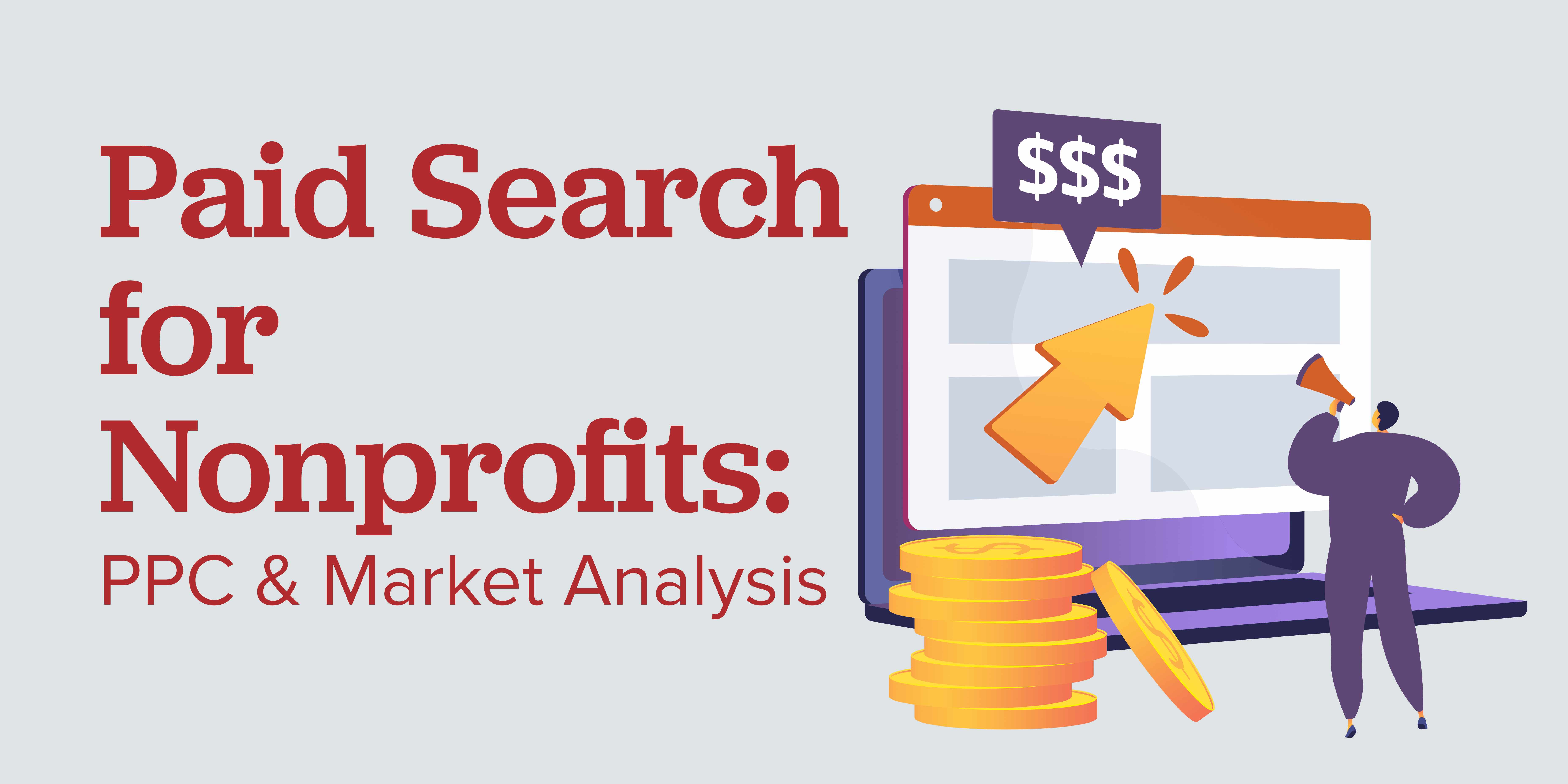Paid Search for Nonprofits: PPC & Market Analysis
Ilia Jones | April 2022

Understanding your target audience is essential for your nonprofit. Competition for funding in the nonprofit sector is fierce, and donor loyalty has waned in recent years. To stay at the forefront of your audience’s mind and maintain access to their funding dollars, you need to know how to target them.
Paid search is one way to get the word out about your nonprofit and drive traffic to your website. However, your paid search campaigns are only as good as your knowledge of the keywords your audience is using. If your paid ads are missing the mark or your cost-per-click is astronomical, it might be time for some market research.
Getting Started with Market Research
Conducting market research means diving into research, data, and analytics to help you understand your audience. It may mean information about your existing donor base. It can also widen the lens to capture information about potential donors or your ideal donors.
Market research can help you better understand:
- Your donor base, their behaviors, and receptiveness to your efforts
- How your current communication strategies are working
- Your brand awareness and opportunities for growth
- The effectiveness of your marketing and advertising campaigns
- How your nonprofit stacks up against others in the area
- How best to work within your budget
As you can see, there are many benefits to market research. These include a better understanding of your existing and target audience to make sure your message is heard loud and clear.
Primary and Secondary Market Research
There are two methods for doing market research. Primary research involves canvassing your existing donor base for more information. Secondary research includes analyzing reports, data, and other publicly available information.
Primary Market Research
Primary market research involves first-hand sources of information. The point of getting this type of individual feedback is to connect with those who have already interacted or donated to your nonprofit. Sending out a survey to your email list, polls on social media, or gathering and interviewing focus groups are all examples of primary market research.
User testing or A/B testing is another way to gain insight into the individual experience without demanding your donor’s time and energy. This approach is particularly good for testing the effectiveness of a new website homepage, paid ad, or social media campaign.
Secondary Market Research
Secondary market research involves gathering and analyzing published and publicly available information. This information may include:
- Market research studies
- Industry reports
- Case studies or white papers
- Industry reports and statistics
- Trending information
- SEO and keyword research
- Competitor analysis
As you can see, there is a wealth of information available to nonprofits. All it requires is time. Target your research to identify data that specifically applies to your organization and cause.
How to Use Market Research to Improve Paid Search
Now that you know how and what to research to help fine-tune your communications, marketing, and advertising strategies, it’s time to put that knowledge to use. One of the best ways to be more efficient with your marketing budget is to reduce your cost-per-click (CPC).
Market research offers you insight into the relevant SEO keywords used by your audience and targeted by your competitors. When you put that knowledge to use, you can lower your CPC.
Here are three strategies for improving your paid search results.
Single Keyword Ad Groups
Single keyword ad groups, or SKAGs, involve using only one super-targeted keyword in a group of ads. When you focus on a single, relevant keyword and craft ad headlines and copy directed to that keyword, you will inevitably see results. Just make sure that your keyword follows the searcher’s intent, which is what makes it relevant, rather than industry jargon or insider language.
How to Make it Work for You
There are a few tricks of the trade to using SKAGs effectively. To make SKAGs work for your nonprofit, here are a few tips.
- Improve your Quality Score and your Click-Through-Rates (CTRs) by choosing relevant keywords that match your ad copy.
- Leverage different match types for your keyword, i.e., exact match, phrase match, etc.
- Use a separate ad campaign to target long-tail keyword searches.
Create Optimized Landing Pages
Your paid ads could all lead back to your nonprofit’s home page or to an event or donation page. Or you could create a customized and optimized landing page for each of your SKAG ads. Which do you think will offer a better user experience?
We won’t keep you in suspense. It’s optimized landing pages!
Sending ad clicks to a page relevant to the search keyword creates a better user experience. It can also help boost your Quality Score.
How to Make it Work For You
Optimized landing pages may seem like a lot of work and maintenance. However, these pages can be simple and effective at raising your conversion rates.
- Remember to keep each landing page relevant and specific to the search term driving the traffic.
- Treat each landing page as your one and only chance to convince the visitor that your nonprofit offers the best solution.
- Offer something of value to the visitor in exchange for their contact information or donation.
Use A/B Testing to Optimize Your Ads
Rather than only trying one ad at a time, test out variations of ads at the same time. This type of approach is known as A/B testing. That’s because you can compare the performance of option A against option B as they run simultaneously. This approach gives you real-world data and insights into ad performance.
But don’t just stop at options A and B. As you fine-tune your ad copy, keep trying new things to try to reduce your CTR even more.
How to make it work for you
There is no limit to the number of paid ads you can run at the same time, aside from budget, of course. So, let your mind run free and see what works!
- Test different headlines and headline combinations.
- Try out different keyword-targeted copy or different phrase combinations.
- Experiment with offers, calls to action, and landing pages.
- Never let yourself be satisfied with your ad performance. Keep trying new things!

